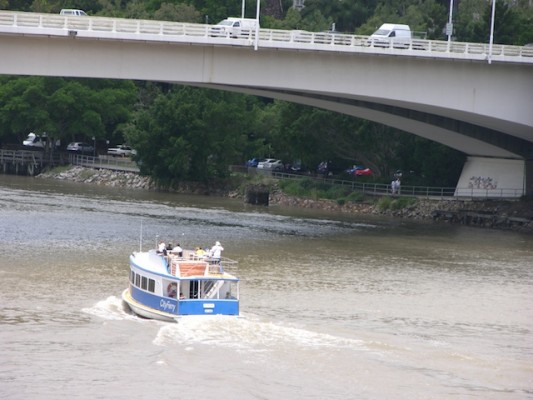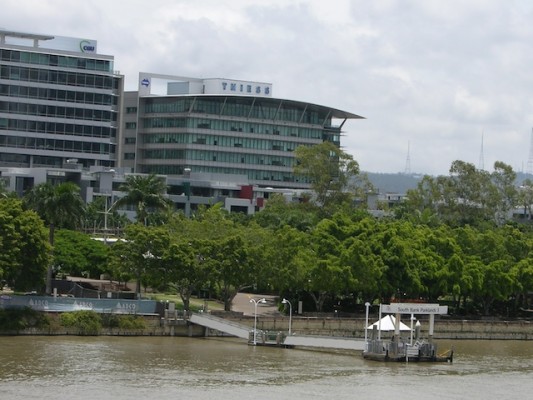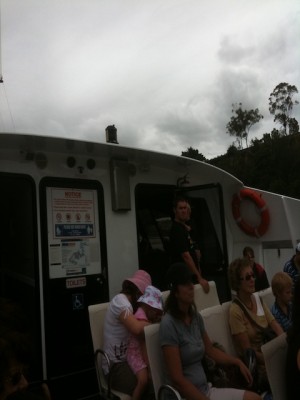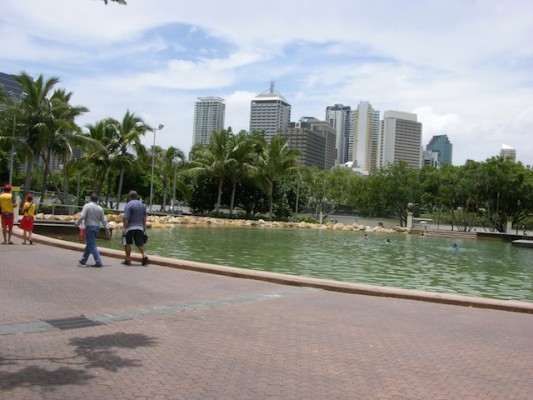Watching PT Collapse
One of the justifications for a good public transport system is that it’s a lifeline for those who need to get around the city - but this week is a reminder of how when the city itself gets hit with an unexpected disaster, public transport vanishes like everything else.
Last week, I was praising the Brisbane trains and the wonderful and popular CityCat ferry service accessed by terminals along the picturesque walkway of the Brisbane river.
Today that ferry service is no more and it will be many months and millions of dollars of infrastructure repairs before the harbour ferry service could possibly resume.
The raging fast flowing Brisbane river has resulted in every ferry terminal not just being submerged but seriously damaged. One estimate this morning put at around $4m per terminal area being needed alone. Riverwalk, a 850-metre floating pedestrian link between the city and New Farm just east of the CBD , broke off overnight and careered down the river as if it were one of the ferries.
Only limited public transport has been running the last 24 hours. When streets are flooded, buses can’t move and there has been the added problem that bus and train drivers did not turn up for work as they had the priority of sorting out their own home problems and if necessary evacuating. Damage to Queensland’s rail system in flooded towns is serious and expensive including whole railbridges being washed away.
Auckland has been lucky. Apart from a few high summer minor grass fires near tracks and a bit of track buckling worries there has been almost no weather disruption in the last few years and even Wellington manages to keep services running most days of winter.
Christchurch had its bus and tram services disrupted by the quake. Recently New Year’s blizzard saw people stranded for 13 hours on stopped trains in the subway -and another blizzard is now hearing New York’s way. European airports had to close over Christmas because of the fierce snow conditions.
With the crazy weather going on, who knows when it will be Auckland’s turn. How will we cope?















17 Comments
Auckland will cope fine - if with increased gridlock - because the population has sufficient private automobile access to provide transportation in the absence of public transport.
It’s about the only upside to being so determinedly dependent on cars.
There would certainly be gridlocked roads if we had to evacuate. Ten times worse than the holiday jams.
The best idea would be to grab a bike and cycle away from the danger area
Auckland basically has only two evacuation routes. If people think holiday traffic is bad we can only dream what would happen during an evacuation!
Volcanic eruption anyone?!
Richard, in that scenario both sides of the motorways would be used for outbound traffic. It’s what they do in the US when a metropolis needs to be evacuated for whatever reason. It doesn’t necessarily prevent gridlock, but it does delay it and offer significantly-increased capacity.
Nick, fortunately we’ll likely have warning of an eruption so evacuation will be able to take place over a period of days. Volcanoes are quite thoughtful in that regard, giving reasonable notice of their intention to demolish your city.
Matt, that alone often is not enough - New Orleans knew about the storm days ago, and still, there was much less evacuation than should have been, in retrospect. Sure, they may not have known about the levees breaking, but neither will we know about the final size of any volcanic eruption (if you live in Westgate, you may think you are safe from a volcano erupting in Howick - until the wind turns…)
Buses will actually be mighty useful in an evacuation, but that presuposes you (still) have fuel and drivers.
Auckland volcanoes are basaltic in nature, so you get a lot of lava and very little ash and explosive gases which makes them relatively safe compared central North Island volcanoes. If the rising magma impacts an underground stream and there is no vent for the steam then a large explosion will occur which is the major hazard.
I think the most likely natural disaster to hit Auckland would be a cyclone striking the city or a tsunami. We have no major rivers to flood and the earthquake risk is relatively low.
Tin foil hats anyone?
Damian, what? Auckland’s vulnerability to natural disasters is not a secret, and the volcanic nature of its foundations is visible to anyone with a functional eye and a brain. How do tin foil hats come into anything?
James, many experts have said that Auckland is at greater risk from volcanoes about which we know nothing than the ones that’ve already had a blow. The next one could emerge in the middle of the harbour (either one), or under some of the parts of South Auckland that’ve got a less-active history than other parts of the city.
There is plenty of evidence of explosive caldera formation in Auckland, who’s to say we won’t have another of those rather than a slower cone?
ARC’s old site had a section on Auckland volcanoes saying: There is about a 5% likelihood of another eruption within the next 50 years. However it could happen anytime and because of the potential consequences, we can’t be complacent.
http://www.arc.govt.nz/albany/index.cfm?1533D1E1-145E-173C-9809-E537E0A45255
I think tsunami is the more dangerous scenario. As stated above, volcanoes usually give a fair amount of advance warning.
A nearby sub-sea quake could cause a tsunami with little or no time to mount a large scale evacuation. Apart from anything else the northern motorway near Onewa Road would be immediately inundated so there goes one of the two main escape routes.
Unfortunately with natural disasters statistics and likelihoods don’t really work very well for providing useful predictions. People get very confused about three floods occurring in three years that are all 1 in 100 year return period floods and this being correct (most will say each one should be 100 years apart!). Natural disaster likelihood is applied to averaging things out over a much longer period than most people really care about (ie more than their life span and even their grandchildren’s lifespan).
At the beginning of 2010 if you asked most people, including geologists, whether you they thought Christchurch or Wellington was more likely to have a significant earthquake they would have said definitely Wellington. They would’ve been wrong although statistically they were correct (subject to whose papers you read).
Gary, the thing about a tsunami is that most of Auckland’s population is not at risk from any given tsunami (as opposed to being at risk from tsunami collectively). There would be damage, and deaths, but most of the coastline is buffered from the majority of the population by hills from any direction.
The CBD is protected quite well by Rangitoto and North Head/Devonport, so despite its status as reclaimed land its vulnerability is not especially significant. Even low-lying parts of south-west and south-east Auckland are huge buffer areas to heavily-populated parts of the remainder of the city, which would suck for the residents of the affected area but still doesn’t change the overall threat to the majority of the population.
I would like to see Auckland (or NZ for that matter) have a bit more education around about what to do if…
On the upside volcano’s and earthquakes in a close proximity (100k’s….) will give warning signs that something is going to happen. What would be quicker is if an earthquake happened further away causing a tsunami. They move pretty quick. But with enough education and the hilly nature of Auckland people could get to high ground pretty quick.
On all events the key is what the population does between the warning and the event. Authorities would have to move quick to notify the population and then the population needs to move quick and not pack everything. Move fast away from the danger zone be sensible and don’t panic.
Nick, if a caldera develops under Auckland the country (and probably the world, given what little is known about them) has much bigger problems.
That said, they’re unlikely to just suddenly occur with no warning. They’re still related to an accumulation of magma and a build-up of pressure beneath the surface, which will result in detectable warning signs. The problem would be seismologists misdiagnosing the scenario in the lack of historical information on what caldera “look like” as they’re preparing to destroy the planet.
Get used to it folks. The world’s a dangerous place——-no one survives!